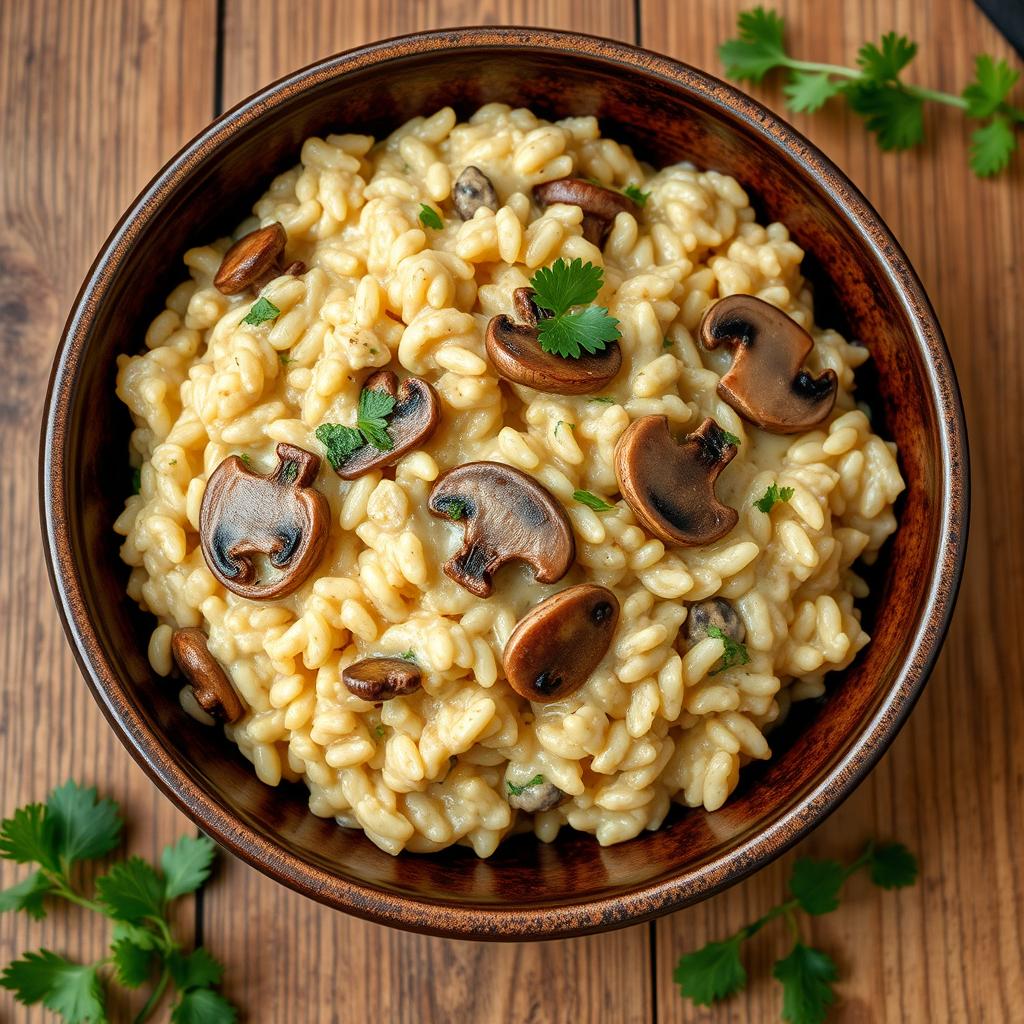10 Steps to Make Restaurant-Quality Mushroom Risotto at Home
Ah, Mushroom Risotto! The very words conjure images of creamy, decadent rice, perfumed with earthy mushrooms and rich Parmesan. This Northern Italian classic is often seen as a dish best left to restaurant chefs, but I’m here to tell you that creating a truly spectacular Mushroom Risotto in your own kitchen is entirely achievable. What makes this dish so special is its transformative power – simple ingredients like rice, broth, and mushrooms are coaxed into a luxurious, comforting meal through a little patience and technique. The key is the slow, deliberate addition of liquid and constant stirring, which releases the starches from the Arborio rice, creating that signature creamy texture without a drop of heavy cream. In this recipe, I’ll show you step-by-step how to master this iconic dish, ensuring a perfectly cooked, flavour-packed risotto every time. Get ready to impress yourself and your guests!
Let’s dive into what you’ll need and how to bring this Italian masterpiece to life.
Quick Information Table
| Prep Time: | 20 minutes |
| Cook Time: | 40-45 minutes |
| Total Time: | 1 hour – 1 hour 5 minutes |
| Difficulty Level: | Medium |
| Servings: | 4 |
| Calories: | Approx. 480-550 per serving |
Ingredients You’ll Need
For the Risotto:
- 1.5 cups (300g) Arborio, Carnaroli, or Vialone Nano rice
- 4-5 cups (1 – 1.25 liters) chicken or vegetable broth, preferably low-sodium
- 1/2 cup (120ml) dry white wine (like Pinot Grigio or Sauvignon Blanc)
- 1 small yellow onion, finely chopped
- 2 cloves garlic, minced
- 2 tablespoons unsalted butter, divided
- 2 tablespoons olive oil
- 1/2 cup (50g) freshly grated Parmesan cheese, plus more for serving
- Salt and freshly ground black pepper to taste
For the Mushrooms:
- 1 pound (450g) mixed fresh mushrooms (e.g., cremini, shiitake, oyster, porcini), sliced or roughly chopped
- Optional: 1/2 ounce (15g) dried porcini mushrooms, rehydrated in 1 cup warm water (reserve soaking liquid)
- 1 tablespoon olive oil
- 1 tablespoon unsalted butter
- 2 tablespoons fresh parsley, chopped, for garnish
Equipment Needed
- Large, heavy-bottomed pot or Dutch oven (at least 4-quart)
- Medium saucepan (for keeping broth warm)
- Ladle
- Sharp knife and cutting board
- Wooden spoon or heatproof spatula for stirring
- Separate skillet for cooking mushrooms
Step-by-Step Instructions
- Prepare Broth & Rehydrate Mushrooms: Pour your broth into the medium saucepan and bring it to a gentle simmer over low heat. Keep it warm throughout the cooking process. If using dried porcini mushrooms, place them in a bowl with 1 cup of warm water and let them rehydrate for at least 20 minutes. Once soft, lift the mushrooms out (reserve the flavourful soaking liquid, straining it through a fine-mesh sieve or coffee filter to remove any grit), chop them, and set aside. Add the strained mushroom liquid to your simmering broth.
- Sauté Aromatics: In your large pot or Dutch oven, heat 1 tablespoon of olive oil and 1 tablespoon of butter over medium heat. Add the finely chopped onion and cook, stirring occasionally, for about 5-7 minutes until softened and translucent, but not browned. Add the minced garlic and cook for another minute until fragrant.
- Toast the Rice: Add the Arborio rice to the pot. Stir continuously for 1-2 minutes, ensuring each grain is coated with fat and lightly toasted. The edges of the rice grains should become slightly translucent. This step is crucial for flavour development.
- Deglaze with Wine: Pour in the white wine. Increase the heat slightly and stir continuously until the wine is fully absorbed and the smell of alcohol has cooked off, about 1-2 minutes.
- Begin Adding Broth: Add one ladleful (about 1/2 cup) of the warm broth (including any reserved mushroom liquid) to the rice. Stir constantly and gently until the liquid is almost fully absorbed. The key is to keep the rice moving to release its starch.
- Cook the Fresh Mushrooms: While the risotto is simmering (and you’re adding broth), heat 1 tablespoon of olive oil and 1 tablespoon of butter in the separate skillet over medium-high heat. Add the fresh sliced/chopped mushrooms (and the rehydrated chopped porcini, if using). Cook, stirring occasionally, until they are nicely browned and have released their liquid, which then evaporates, about 8-10 minutes. Season with a pinch of salt and pepper. Set aside.
- Continue Adding Broth & Stirring: Continue adding the warm broth, one ladleful at a time, waiting until each addition is almost completely absorbed before adding the next. Stir frequently and consistently. This process will take about 18-25 minutes in total from the first broth addition. The frequent stirring is what creates the creamy texture.
- Check for Doneness: After about 18 minutes, start tasting the rice. You’re looking for an al dente texture – cooked through but with a slight bite in the center. The risotto should be creamy, a little soupy, and flow gently if you tilt the pot; it shouldn’t be stiff or dry. If you run out of broth and the rice isn’t quite done, you can add a little hot water.
- Incorporate Mushrooms & Finish (Mantecatura): Once the rice is al dente, remove the pot from the heat. Stir in the cooked mushrooms. Add the remaining 1 tablespoon of cold, cubed butter and the freshly grated Parmesan cheese. Stir vigorously for about 1 minute. This step, called “mantecatura,” emulsifies the fats and starches, making the risotto exceptionally creamy.
- Rest and Serve: Taste and adjust seasoning with salt and freshly ground black pepper as needed. Cover the pot and let the risotto rest for 2-3 minutes. This allows the flavours to meld and the texture to become even more luxurious. Serve immediately in warmed bowls, garnished with fresh chopped parsley and an extra grating of Parmesan cheese.
Pro Tips for Success
- Warm Broth is Key: Adding cold broth to hot rice will cool everything down and shock the rice, leading to uneven cooking and a less creamy result. Always keep your broth at a gentle simmer.
- Don’t Wash the Rice: The starch on the surface of Arborio rice is essential for achieving that classic creamy texture. Washing it will remove this vital component.
- Stir, Stir, Stir (But Gently): Constant, gentle stirring is crucial. It helps release the rice’s starch, which creates the creaminess. However, avoid overly vigorous stirring that could break the grains.
- Sauté Mushrooms Separately: Cooking mushrooms separately allows them to brown properly and develop a deep, umami flavour without making the risotto watery. Add them towards the end.
- Patience Pays Off: Risotto isn’t a dish to be rushed. The gradual addition of liquid and consistent stirring is what builds its character. Enjoy the process!
- Make-Ahead/Storage: Risotto is best enjoyed immediately. If you have leftovers, store them in an airtight container in the refrigerator for up to 3 days. Reheat gently on the stovetop with a splash of broth or water to restore creaminess. Avoid microwaving if possible, as it can make the rice gummy.
How to Serve and Present
Mushroom Risotto is a star in its own right but also pairs beautifully with other elements.
- Garnishes: A sprinkle of fresh chopped parsley or chives adds a touch of freshness and color. A drizzle of good quality extra virgin olive oil or truffle oil (if you’re a fan) right before serving can elevate it further. Of course, more freshly grated Parmesan is always welcome.
- Accompaniments: Serve as a main course with a simple side salad dressed with a light vinaigrette. It can also be an elegant side dish to grilled chicken, seared scallops, or a perfectly cooked steak.
- Wine Pairing: A crisp, dry white wine like Pinot Grigio, Sauvignon Blanc, or an unoaked Chardonnay complements the richness of the risotto. For red wine lovers, a light-bodied Pinot Noir can also work well.
- Plating: Serve in wide, shallow bowls. Gently spoon the risotto into the center and give the bowl a little shake to help it spread naturally.
Variations to Try
- Truffle Mushroom Risotto: For an extra touch of luxury, stir in a teaspoon of black or white truffle oil along with the butter and Parmesan at the end, or garnish with freshly shaved truffles if available.
- Vegan Mushroom Risotto: Use a good quality vegetable broth. Sauté onions and garlic in olive oil. Omit the butter and Parmesan, or replace Parmesan with 2-3 tablespoons of nutritional yeast for a cheesy flavour and use a vegan butter substitute.
- Add Greens: Stir in a handful of baby spinach or arugula during the last few minutes of cooking until just wilted for added nutrients and a peppery bite. Blanched asparagus tips or peas also work wonderfully.
FAQ Section
-
Q: Can I use regular long-grain rice instead of Arborio?
A: While you can make a rice dish, it won’t be true risotto. Arborio, Carnaroli, or Vialone Nano rice varieties have high amylopectin starch content, which is released during cooking to create the characteristic creamy texture. Long-grain rice has less of this starch.
-
Q: Why is my risotto gummy or too thick?
A: This can happen if the rice is overcooked, if too much liquid was added at once, or if it wasn’t stirred enough initially. It can also become thick if it sits for too long before serving. Aim for a “wave” consistency – it should flow gently.
-
Q: My risotto is bland. How can I add more flavour?
A: Ensure your broth is well-seasoned. Using a mix of mushrooms, especially some dried porcini and their soaking liquid, adds incredible depth. Don’t skip toasting the rice or deglazing with wine. Season generously with salt and pepper at the end. Good quality Parmesan cheese also makes a big difference.
-
Q: Can I make risotto ahead of time for a dinner party?
A: Risotto is best served immediately. However, you can par-cook it. Cook the risotto until it’s about halfway done (still quite al dente and a bit soupy). Spread it on a baking sheet to cool quickly, then refrigerate. When ready to serve, return it to a pot with more warm broth and finish cooking, adding the mushrooms, butter, and Parmesan at the end.
-
Q: What are the best types of fresh mushrooms to use?
A: A combination is often best for depth of flavour and texture. Cremini (baby bellas) provide a good base. Shiitake mushrooms offer a meatier texture and more intense umami. Oyster mushrooms are delicate and tender. Wild mushrooms like chanterelles or morels are fantastic if in season and available.
Conclusion
Creating restaurant-quality Mushroom Risotto at home is a truly rewarding culinary experience. With a little patience and by following these steps, you can achieve that perfect creamy texture and deep, earthy flavour that makes this dish so beloved. The rhythmic stirring, the gradual transformation of simple grains into a luxurious meal – it’s a process to be savoured.
Now that you have the ultimate guide, I encourage you to gather your ingredients and embark on this delicious journey. Don’t be intimidated; embrace the process! I’d love to hear how your Mushroom Risotto turns out. Share your results and any personal twists in the comments below! Happy cooking!
If you enjoyed this recipe, you might also like our guides to Classic Lasagna Bolognese or Homemade Gnocchi.

